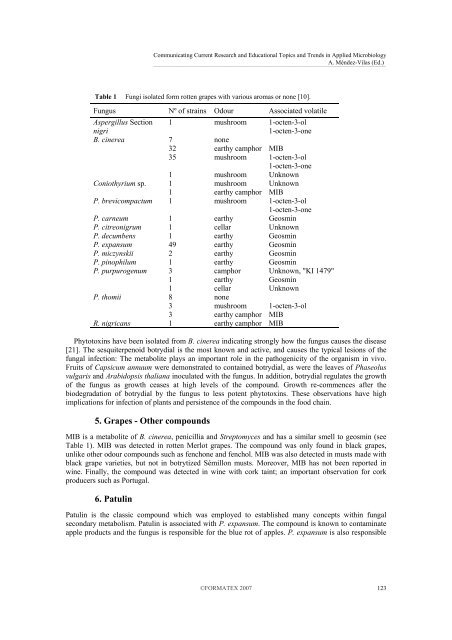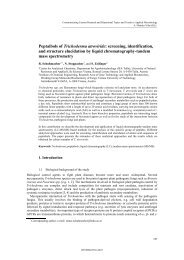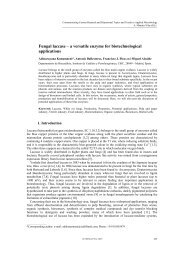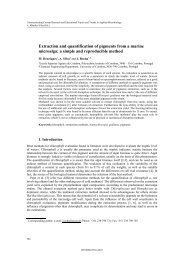Why do food and drink smell like earth? - Formatex Research Center
Why do food and drink smell like earth? - Formatex Research Center
Why do food and drink smell like earth? - Formatex Research Center
Create successful ePaper yourself
Turn your PDF publications into a flip-book with our unique Google optimized e-Paper software.
Table 1 Fungi isolated form rotten grapes with various aromas or none [10].<br />
Fungus Nº of strains O<strong>do</strong>ur Associated volatile<br />
Aspergillus Section 1 mushroom 1-octen-3-ol<br />
nigri<br />
1-octen-3-one<br />
B. cinerea 7 none<br />
32 <strong>earth</strong>y camphor MIB<br />
35 mushroom 1-octen-3-ol<br />
1-octen-3-one<br />
1 mushroom Unknown<br />
Coniothyrium sp. 1 mushroom Unknown<br />
1 <strong>earth</strong>y camphor MIB<br />
P. brevicompactum 1 mushroom 1-octen-3-ol<br />
1-octen-3-one<br />
P. carneum 1 <strong>earth</strong>y Geosmin<br />
P. citreonigrum 1 cellar Unknown<br />
P. decumbens 1 <strong>earth</strong>y Geosmin<br />
P. expansum 49 <strong>earth</strong>y Geosmin<br />
P. miczynskii 2 <strong>earth</strong>y Geosmin<br />
P. pinophilum 1 <strong>earth</strong>y Geosmin<br />
P. purpurogenum 3 camphor Unknown, "KI 1479"<br />
1 <strong>earth</strong>y Geosmin<br />
1 cellar Unknown<br />
P. thomii 8 none<br />
3 mushroom 1-octen-3-ol<br />
3 <strong>earth</strong>y camphor MIB<br />
R. nigricans 1 <strong>earth</strong>y camphor MIB<br />
Phytotoxins have been isolated from B. cinerea indicating strongly how the fungus causes the disease<br />
[21]. The sesquiterpenoid botrydial is the most known <strong>and</strong> active, <strong>and</strong> causes the typical lesions of the<br />
fungal infection: The metabolite plays an important role in the pathogenicity of the organism in vivo.<br />
Fruits of Capsicum annuum were demonstrated to contained botrydial, as were the leaves of Phaseolus<br />
vulgaris <strong>and</strong> Arabi<strong>do</strong>psis thaliana inoculated with the fungus. In addition, botrydial regulates the growth<br />
of the fungus as growth ceases at high levels of the compound. Growth re-commences after the<br />
biodegradation of botrydial by the fungus to less potent phytotoxins. These observations have high<br />
implications for infection of plants <strong>and</strong> persistence of the compounds in the <strong>food</strong> chain.<br />
5. Grapes - Other compounds<br />
MIB is a metabolite of B. cinerea, penicillia <strong>and</strong> Streptomyces <strong>and</strong> has a similar <strong>smell</strong> to geosmin (see<br />
Table 1). MIB was detected in rotten Merlot grapes. The compound was only found in black grapes,<br />
un<strong>like</strong> other o<strong>do</strong>ur compounds such as fenchone <strong>and</strong> fenchol. MIB was also detected in musts made with<br />
black grape varieties, but not in botrytized Sémillon musts. Moreover, MIB has not been reported in<br />
wine. Finally, the compound was detected in wine with cork taint; an important observation for cork<br />
producers such as Portugal.<br />
6. Patulin<br />
Communicating Current <strong>Research</strong> <strong>and</strong> Educational Topics <strong>and</strong> Trends in Applied Microbiology<br />
_____________________________________________________________________<br />
A. Méndez-Vilas (Ed.)<br />
Patulin is the classic compound which was employed to established many concepts within fungal<br />
secondary metabolism. Patulin is associated with P. expansum. The compound is known to contaminate<br />
apple products <strong>and</strong> the fungus is responsible for the blue rot of apples. P. expansum is also responsible<br />
©FORMATEX 2007<br />
123









